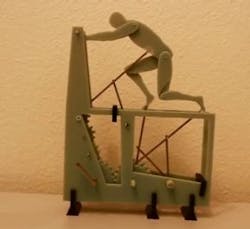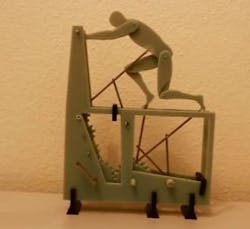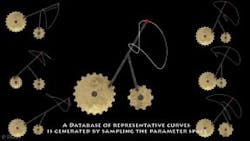New role for kinematics software: Defining mechanized dinosaurs
Kinematics software that helps synthesize four-bar linkages and related mechanisms has been around for decades. But this software specialty recently became more interesting thanks to work by researchers at Disney Research in Zurich and Boston, and at the Massachusetts Institute of Technology's Computer Science and Artificial Intelligence Lab (CSAIL).
Speaking at the recent ACM Siggraph 2013 International Conference on Computer Graphics and Interactive Techniques, they described specialized kinematics programs they have devised that help build mechanized characters, such as clockwork automatons that move using a series of gears and linkages.
Users of the Disney software start with an articulated character in mind, then tell the software how specific points on it should move. For example, the user might tell the software what kind of a motion profile the knee and foot should trace out, much in the way the user of a four-bar linkage program might tell the software how the end of the linkage should move. The software then suggests mechanisms from a database of eight distinct types of mechanisms and four driving mechanisms that would synthesize the necessary motion. Moreover, the mechanical assemblies that result from this process can be fabricated with rapid prototyping devices, researchers say.
Given a specific motion profile to generate, the software starts with a candidate mechanism that has specific properties that are expressed as parameters. The software iteratively varies the parameters to get an optimized version of the mechanism that will best synthesize the profile.
For example, the user might first specify the location of pin joints where the mechanism connects to the character. The software might then vary the location of point-on-line connections between individual parts of the mechanism as well as positions of the support shafts.
The software handles the timing of specific character motions through the use of noncircular gear pairs: A constant angular velocity applied to the first gear gets transformed into a variable angular velocity on the second. The timing of the resulting movement depends on the profiles of the two noncircular gears involved and on the the ratio of their radii where they mesh. The user defines the relative action between the two gears.
The software automatically determines the number of gears needed on a single plane depending on the signs of the angular velocities, the distance between them, and their radii. But gears can occupy more than one plane but be on the same axis. In either case, the software runs optimizations that consider constraints such as the thickness of the gears and requiements that gears are not closer than the average gear thickness. The software also checks for collisions between gears, linkages, and body parts.
Researchers say the process of designing the motions and corresponding drive mechanisms take about a half hour in examples they've tried. The software also can devise mechanisms that occupy a gearbox typically residing below the character or can sit inside the character itself.
Future plans for the work include incorporating structural analysis to ensure the resulting assemblies are light weight but don't break. The existing program is also limited to cyclic motion, but researchers think they can eventually come up with motions don't repeat every cycle.
About the Author
Leland Teschler
Lee Teschler served as Editor-in-Chief of Machine Design until 2014. He holds a B.S. Engineering from the University of Michigan; a B.S. Electrical Engineering from the University of Michigan; and an MBA from Cleveland State University. Prior to joining Penton, Lee worked as a Communications design engineer for the U.S. Government.


